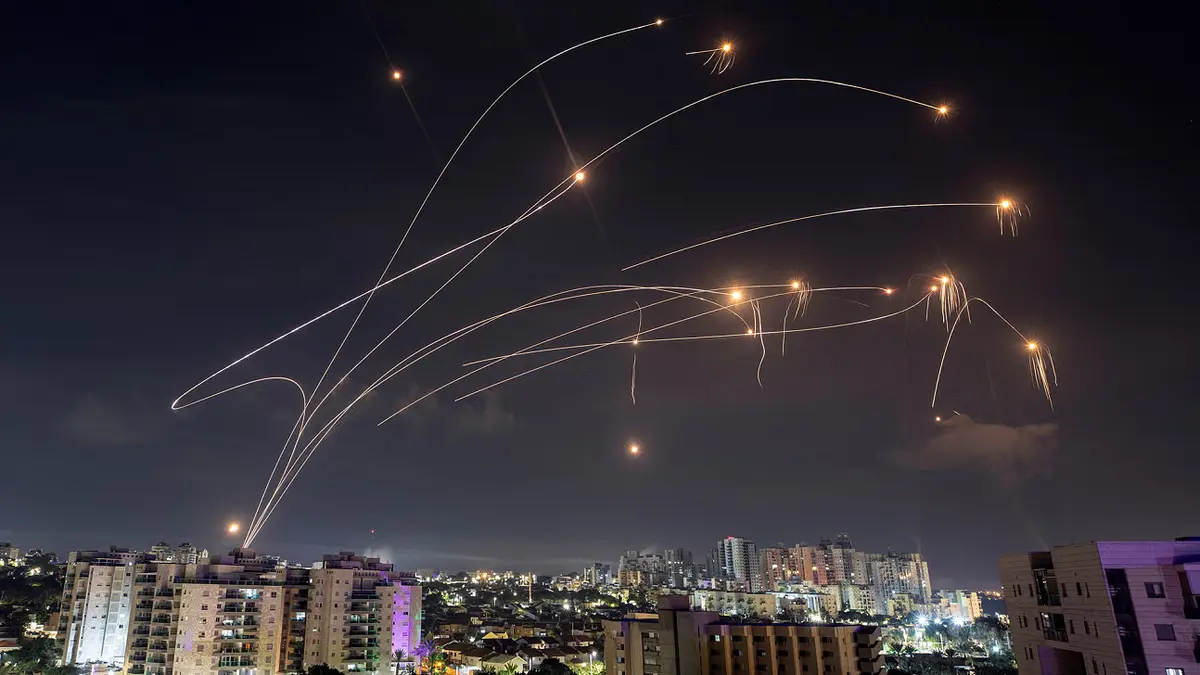On June 13, 2025, Iran launched a major ballistic missile and drone counterattack against Israel following unprecedented Israeli airstrikes on its nuclear and military facilities. While most of the barrage was intercepted, some projectiles penetrated Israeli defenses, causing limited damage and testing the resilience of systems such as Iron Dome, David’s Sling, and Arrow.
Missile Barrage and Iran’s Aim
Iranian state media, IRNA, reported that “hundreds” of ballistic missiles and drones were fired at Israel in retaliation for the June 13 attack that killed senior IRGC commanders and nuclear scientists . Israeli officials put the figure at less than 100 missiles, with sirens sounding intermittently in two separate attacks in Tel Aviv and Jerusalem. The waves were described as “waves”.
IRGC Commander General Hossein Salami declared the attack a “declaration of war,” warning that Israel would face a “painful fate” if the threats were carried out. Tehran insisted that its aim was to demonstrate strategic capability rather than inflict large-scale casualties.
Israel’s integrated defense response
The Israel Defense Forces (IDF) credited its multi-layered defense shield for neutralizing most of the threats. Rear Admiral Daniel Hagari reported that the combined Arrow, David’s Sling, and Iron Dome systems intercepted “most” of the incoming missiles, calling them “serious and dangerous incursions” that were successfully mitigated.
However, some missiles breached this shield. One hit the Kirya military headquarters in Tel Aviv, causing structural damage, while the other hit a residential building in Rishon Lezion – resulting in the deaths of two civilians and injuries to dozens.
Detailed damage assessment
- Attack on military headquarters: A missile hit near the IDF’s Kirya command center, causing partial structural damage; internal assessment ongoing.
- Residential casualties: In Tel Aviv, mainly in Rishon Lezion and Ramat Gan, at least two civilians were killed, one seriously, and dozens were injured.
- Impact on urban infrastructure: Several residential buildings showed signs of fire and structural damage. There were craters, broken windows, and burned-out vehicles; emergency teams rescued several residents from the damaged structures.
While overall damage was limited, it was more severe than usual due to the quantity and range of missiles fired – underscoring the importance of strong air-defense layers.
Air-defense Systems: Hits and Misses
- Iron Dome successfully intercepted most short-range rockets, although many medium-range projectiles slipped through layered coverage.
- David’s Sling and Arrow-2/3 systems intercepted and destroyed several missile threats. Reliable U.S. sources confirm that one Arrow-3 system achieved an outer-atmospheric interception.
- Nevertheless, the saturation-level volley exposed useful gaps in missile stockpiles and response coordination, leading IDF leaders to call for rapid redeployment and system upgrades.
A senior IDF strategist noted, “Our systems were successful, but Iran tested us – they exposed areas for improvement.” His statement included mixed victories – the defense was successful, but paid a price.
Strategic and regional implications
The Iranian direct attack – Tehran’s largest airstrike on Israeli cities to date – represents a significant escalation. The use of the new Qassem Basir missile adds complexity, as the design bypasses some defensive countermeasures. In turn, Israel has signaled that it will continue airstrikes in Iran until Tehran can contain the missile threat.
International actors have called for calm. The UN and EU, along with Turkey and France, have urged restraint, wary that further escalation could destabilize the Middle East and derail nuclear diplomacy.
The way forward: escalation or stability?
Iran has declared readiness for additional missile waves – but its ability to sustain a large-scale barrage may be limited by structural damage and local constraints. Israel, though defensively capable, is now increasing its interceptor inventory, increasing system integration and focusing on fortifying civilian shelters.
As one IDF source put it, “We have got the message.” Now is the time to prepare for the next round.” The coming days are likely to test whether deterrence remains or increases.
Read More: Russia Accuses UK and US of Plotting Sabotage in ‘NATO Lake’ – National Security
FAQs
Iran launched missile and drone strikes in response to Israeli airstrikes on its nuclear and military sites. The attack killed senior IRGC commanders and nuclear scientists. Tehran said the attack was not primarily intended to inflict large-scale casualties but to demonstrate its military power and ability to directly strike Israeli cities.
Israel used its layered defenses – Iron Dome, David’s Sling, and Arrow systems – to intercept most incoming missiles and drones. While the systems worked well, some missiles managed to hit Tel Aviv and Rishon LeZion. This shows that even strong defense shields can withstand pressure when a large number of missiles are launched simultaneously.
Most of the missiles were intercepted, but some landed in sensitive areas. One missile damaged part of the Kirya military base in Tel Aviv. Another strike hit a residential building in Rishon Lezion, killing two civilians and injuring dozens. Some areas saw burnt-out cars, broken windows and fire damage, although the overall destruction was limited compared to the scale of the attack.
The attack has raised fears of a wider conflict in the Middle East. New missiles, such as the Qassem Bashir, designed to bypass defenses, have raised global concerns. The UN, European Union, Turkey and France have called for calm, expressing concerns that further attacks could affect oil markets, nuclear talks and regional stability. On Google Trends, topics like “Iran missiles”, “Iron Dome demonstration” and “Middle East conflict 2025” are trending as people follow the latest updates.








Leave a Reply